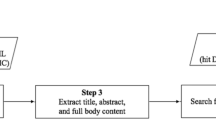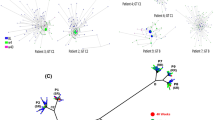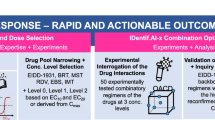Abstract
Highly active antiretroviral therapy (HAART), in which three or more drugs are given in combination, has substantially improved the clinical management of HIV-1 infection. Still, the emergence of drug-resistant variants eventually leads to therapy failure in most patients. In such a scenario, the high diversity of resistance-associated mutational patterns complicates the choice of an optimal follow-up regimen. To support physicians in this task, a range of bioinformatics tools for predicting drug resistance or response to combination therapy from the viral genotype have been developed. With several free and commercial software services available, computational advice is rapidly gaining acceptance as an important element of rational decision-making in the treatment of HIV infection.
This is a preview of subscription content, access via your institution
Access options
Subscribe to this journal
Receive 12 print issues and online access
$209.00 per year
only $17.42 per issue
Buy this article
- Purchase on Springer Link
- Instant access to full article PDF
Prices may be subject to local taxes which are calculated during checkout




Similar content being viewed by others
References
UNAIDS. AIDS epidemic update: December 2005. UNAIDS web site [online], <http://www.unaids.org/epi/2005> (2005).
Sing, T. & Däumer, M. in Antiretroviral Resistance in Clinical Practice (ed. Geretti, A. M.) 43–56 (Mediscript, London, 2005).
Hastie, T., Tibshirani, R. & Friedman, J. The Elements of Statistical Learning (Springer, New York, 2001).
Reeves, J. D. & Piefer, A. J. Emerging drug targets for antiretroviral therapy. Drugs 65, 1747–1766 (2005).
Vermeiren, H. et al. Application of multiple linear regression modelling to the quantitative prediction of HIV-1 drug susceptibility phenotype from viral genotype. Antivir. Ther. 9, S122 (2004).
Wang, K., Jenwitheesuk, E., Samudrala, R. & Mittler, J. E. Simple linear model provides highly accurate genotypic predictions of HIV-1 drug resistance. Antivir. Ther. 9, 343–352 (2004).
Sevin, A. D. et al. Methods for investigation of the relationship between drug-susceptibility phenotype and human immunodeficiency virus type 1 genotype with applications to AIDS clinical trials group 333. J. Infect. Dis. 182, 59–67 (2000).
Foulkes, A. S. & De Gruttola, V. Characterizing the relationship between HIV-1 genotype and phenotype: prediction-based classification. Biometrics 58, 145–156 (2002).
Foulkes, A. S. & De Gruttola, V. Characterizing classes of antiretroviral drugs by genotype. Stat. Med. 22, 2637–2655 (2003).
Wang, D. & Larder, B. Enhanced prediction of lopinavir resistance from genotype by use of artificial neural networks. J. Infect. Dis. 188, 653–660 (2003).
Potter, R. B. & Draghici, S. A SOFM approach to predicting HIV drug resistance. Pac. Symp. Biocomput. 77–87 (2002).
Beerenwinkel, N. et al. Diversity and complexity of HIV-1 drug resistance: a bioinformatics approach to predicting phenotype from genotype. Proc. Natl Acad. Sci. USA 99, 8271–8276 (2002).
Beerenwinkel, N. et al. Geno2pheno: estimating phenotypic drug resistance from HIV-1 genotypes. Nucleic Acids Res. 31, 3850–3855 (2003).
Larder, B. et al. Predicting HIV-1 phenotypic resistance from genotype using a large phenotype–genotype relational database. Antivir. Ther. 4, S59 (1999).
DiRienzo, A. G., De Gruttola, V., Larder, B. & Hertogs, K. Non-parametric methods to predict HIV drug susceptibility phenotype from genotype. Stat. Med. 22, 2785–2798 (2003).
Rabinowitz, M. et al. Accurate prediction of HIV-1 drug response from the reverse transcriptase and protease amino acid sequences using sparse models created by convex optimization. Bioinformatics 22, 541–549 (2006).
Van Houtte, M. et al. The VirtualPhenotype analysis of an HIV-1 genotype provides a more accurate prediction of drug susceptibility than a single phenotype measurement. Proc. 13th Int. Symp. HIV Emerging Infect. Dis. (2004).
Jenwitheesuk, E., Wang, K., Mittler, J. E. & Samudrala, R. Improved accuracy of HIV-1 genotypic susceptibility interpretation using a consensus approach. AIDS 18, 1858–1859 (2004).
Wang, K., Samudrala, R. & Mittler, J. E. HIV-1 genotypic drug-resistance interpretation algorithms need to include hypersusceptibility-associated mutations. J. Infect. Dis. 190, 2055–2056 (2004).
Jenwitheesuk, E. & Samudrala, R. Prediction of HIV-1 protease inhibitor resistance using a protein-inhibitor flexible docking approach. Antivir. Ther. 10, 157–166 (2005).
Draghici, S. & Potter, R. B. Predicting HIV drug resistance with neural networks. Bioinformatics 19, 98–107 (2003).
Shenderovich, M. D., Kagan, R. M., Heseltine, P. N. & Ramnarayan, K. Structure-based phenotyping predicts HIV-1 protease inhibitor resistance. Protein Sci. 12, 1706–1718 (2003).
Jenwitheesuk, E. & Samudrala, R. Improved prediction of HIV-1 protease-inhibitor binding energies by molecular dynamics simulations. BMC Struct. Biol. 3, Article 2 (2003).
Maggio, E. T., Shenderovich, M., Kagan, R., Goddette, D. & Ramnarayan, K. Structural pharmacogenomics, drug resistance and the design of anti-infective super-drugs. Drug Discov. Today 7, 1214–1220 (2002).
Cao, Z. W. et al. Computer prediction of drug resistance mutations in proteins. Drug Discov. Today 10, 521–529 (2005).
Jenwitheesuk, E., Wang, K., Mittler, J. E. & Samudrala, R. PIRSpred: a web server for reliable HIV-1 protein-inhibitor resistance/susceptibility prediction. Trends Microbiol. 13, 150–151 (2005).
Beerenwinkel, N. et al. Geno2pheno: interpreting genotypic HIV drug resistance tests. IEEE Intelligent Syst. 16, 35–41 (2001).
Brun-Vezinet, F. et al. Clinically validated genotype analysis: guiding principles and statistical concerns. Antivir. Ther. 9, 465–478 (2004).
Flandre, P. et al. Comparison of tests and procedures to build clinically relevant genotypic scores: application to the Jaguar study. Antivir. Ther. 10, 479–487 (2005).
Clavel, F., Soriano, V. & Zolopa, A. R. in HIV infection 101–107 (Bash Medical Publishing, Paris, 2004).
Swanstrom, R. et al. Weighted phenotypic susceptibility scores are predictive of the HIV-1 RNA response in protease inhibitor-experienced HIV-1-infected subjects. J. Infect. Dis. 190, 886–893 (2004).
Beerenwinkel, N. et al. Methods for optimizing antiviral combination therapies. Bioinformatics 19 (Suppl. 1), i16–i25 (2003).
Bacheler, L. et al. Estimation of phenotypic clinical cutoffs for VirtualPhenotype through meta analyses of clinical trial and cohort data. Antivir. Ther. 9, S154 (2004).
Nowak, M. A. & May, R. M. Virus Dynamics (Oxford Univ. Press, Oxford, 2000).
Wodarz, D. & Nowak, M. A. Mathematical models of HIV pathogenesis and treatment. Bioessays 24, 1178–1187 (2002).
Csajka, C. & Verotta, D. Pharmacokinetic–pharmacodynamic modelling: history and perspectives. J. Pharmacokinet. Pharmacodyn. 33, 227–279 (2006).
Prosperi, M. et al. 'Common law' applied to treatment decisions for drug resistant HIV. Antivir. Ther. 10, S62 (2005).
DeGruttola, V. et al. The relation between baseline HIV drug resistance and response to antiretroviral therapy: re-analysis of retrospective and prospective studies using a standardized data analysis plan. Antivir. Ther. 5, 41–48 (2000).
Savenkov, I. et al. HAART outcome prediction using statistical learning methods. Antivir. Ther. 10, S60 (2005).
Lathrop, R. & Pazzani, M. Combinatorial optimization in rapidly mutating drug-resistant viruses. J. Comb. Optim. 3, 301–320 (1999).
Beerenwinkel, N. et al. Estimating HIV evolutionary pathways and the genetic barrier to drug resistance. J. Infect. Dis. 191, 1953–1960 (2005).
Foulkes, A. S. & De Gruttola, V. Characterizing the progression of viral mutations over time. J. Am. Stat. Assoc. 98, 859–867 (2003).
Beerenwinkel, N. & Drton, M. A mutagenetic tree hidden Markov model for longitudinal clonal HIV sequence data. Biostatistics (in the press).
Sloot, P. M., Boukhanovsky, A. V., Keulen, W., Tirado-Ramos, A. & Boucher, C. A. A Grid-based HIV expert system. J. Clin. Monit. Comput. 19, 263–278 (2005).
Segal, M. R., Barbour, J. D. & Grant, R. M. Relating HIV-1 sequence variation to replication capacity via trees and forests. Stat. Appl. Genet. Mol. Biol. 3, Article 2 (2004).
Birkner, M. D., Sinisi, S. E. & Van der Laan, M. Multiple testing and data adaptive regression: an application to HIV-1 sequence data. Stat. Appl. Genet. Mol. Biol. 4, Article 8 (2005).
Larder, B. et al. Treatment history and adherence information significantly improves prediction of virological response by neural networks. Antivir. Ther. 10, S57 (2005).
Marcelin, A. G. et al. Virological and pharmacological parameters predicting the response to lopinavir-ritonavir in heavily protease inhibitor-experienced patients. Antimicrob. Agents Chemother. 49, 1720–1726 (2005).
Rendon, A. et al. Clinical benefit of interventions driven by therapeutic drug monitoring. HIV Med. 6, 360–365 (2005).
Marcelin, A. G. et al. Genotypic inhibitory quotient as predictor of virological response to ritonavir–amprenavir in human immunodeficiency virus type 1 protease inhibitor-experienced patients. Antimicrob. Agents Chemother. 47, 594–600 (2003).
Wahl, L. M. & Nowak, M. A. Adherence and drug resistance: predictions for therapy outcome. Proc. Biol. Sci. 267, 835–843 (2000).
Jiang, H. et al. Assessing resistance costs of antiretroviral therapies via measures of future drug options. J. Infect. Dis. 188, 1001–1008 (2003).
Johnson, V. A. et al. Update of the drug resistance mutations in HIV-1: fall 2005. Top. HIV Med. 13, 125–131 (2005).
Roomp, K. et al. in Data Integration in the Life Sciences (eds Leser, U., Naumann, F. & Eckman, B. A.) 185–194 (Springer, New York, 2006).
Cozzi-Lepri, A. et al. Thymidine analogue mutation profiles: factors associated with acquiring specific profiles and their impact on the virological response to therapy. Antivir. Ther. 10, 791–802 (2005).
Acknowledgements
We are indebted to M. Zazzi, R. Harrigan, and three anonymous referees for their detailed and helpful comments. Thanks to A. Altmann and M. Däumer for help on preparing Figure 4. We thank R.W. Shafer, B. Larder, A. Altmann and N. Beerenwinkel for allowing us to discuss their submitted manuscripts. Our work is supported by the European Union, as part of the EuResist project.
Author information
Authors and Affiliations
Corresponding author
Ethics declarations
Competing interests
The authors declare no competing financial interests.
Related links
Related links
DATABASES
Entrez Genome
UniProtKB
FURTHER INFORMATION
FDA approved drugs used in the treatment of HIV
HIV Resistance Response Database Initiative
PIRSpred — protein inhibitor resistance/susceptibility prediction
Stanford University HIV Drug Resistance Database
Glossary
- Classification problem
-
A classification problem aims to categorize an input x into one of a finite set of categories. Often only two categories are used. For example, the categories could be resistant or susceptible (or resistant, intermediate or susceptible) if the input is a viral genotype together with a drug, based on suitable resistance-factor cutoffs.
- Cross-validation
-
A method for assessing the prediction accuracy of a statistical model. The training data set is divided into, for example, ten equal-sized parts. The statistical model is derived ('learned') on nine parts and is then tested on the tenth part. In ten trials, each part is used in turn for testing.
- Drug activity
-
A value that is reciprocal to viral resistance. Drug activity can be normalized, thereby allowing comparison between different drugs (for example, drug activity ranging from 0 (not active) to 1 (maximally active)).
- Homology-based modelling method
-
A method that allows the three-dimensional structure of a 'query' protein to be modelled on that of a structurally known 'template' protein.
- Hypersusceptibility
-
A resensitization effect in which a virus encoding resistance mutations becomes more susceptible to a drug than the reference virus.
- Molecular docking method
-
A procedure by which the conformation of a ligand that interacts with the binding site of a structurally known protein is computed.
- Molecular dynamics simulation
-
A time-consuming computational method that simulates molecular movements by computing the forces that act on the molecules.
- Regression problem
-
A regression problem aims to approximate a real-valued output y = f(x) given the input x, and based on a set of training data (xi, yi). Here, the input is a viral genotype together with a drug, and the output is a quantitative measure of the resistance of the virus against the drug, such as the resistance factor of the virus.
- Resensitization
-
An effect by which a mutation that confers resistance to one drug can increase the susceptibility of the virus to another drug.
- Resistance-factor cutoff
-
A number that is used to assign a resistance category to a virus, based on its resistance factor. For example, to categorize viruses into susceptible, intermediate or resistant, two resistance-factor cutoffs (c1, c2) are chosen. The virus is said to be susceptible if its resistance factor is below c1, and is resistant if the resistance factor is above c2. Otherwise, the virus has intermediate resistance.
- Rule-based algorithm
-
An algorithmic decision procedure that is based on identified resistance mutations and coded in the form of sets of propositional rules. Although rule sets can be learned using statistical learning methods, it is current practice in the HIV community to assemble them using panels of human experts.
- Statistical learning methods
-
Algorithms for deriving computational models that can predict unseen output from available input. Such models are derived from sets of 'training data'. The training data comprise inputs together with their associated known outputs.
Rights and permissions
About this article
Cite this article
Lengauer, T., Sing, T. Bioinformatics-assisted anti-HIV therapy. Nat Rev Microbiol 4, 790–797 (2006). https://doi.org/10.1038/nrmicro1477
Issue Date:
DOI: https://doi.org/10.1038/nrmicro1477
This article is cited by
-
Vision for Improving Pregnancy Health: Innovation and the Future of Pregnancy Research
Reproductive Sciences (2022)
-
Machine learning with asymmetric abstention for biomedical decision-making
BMC Medical Informatics and Decision Making (2021)
-
Gaussian noise up-sampling is better suited than SMOTE and ADASYN for clinical decision making
BioData Mining (2021)
-
Accurate Prediction for Antibody Resistance of Clinical HIV-1 Isolates
Scientific Reports (2019)
-
Antibody-mediated prevention and treatment of HIV-1 infection
Retrovirology (2018)



